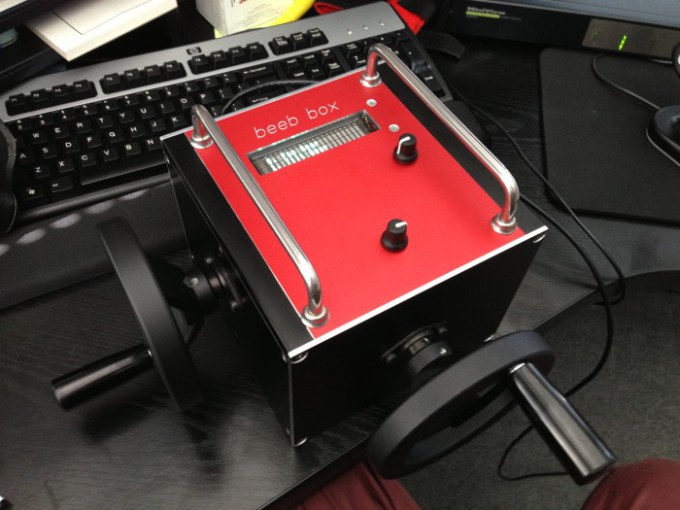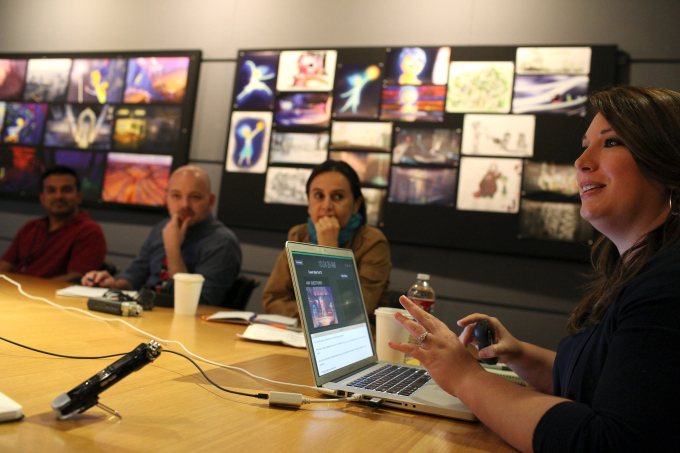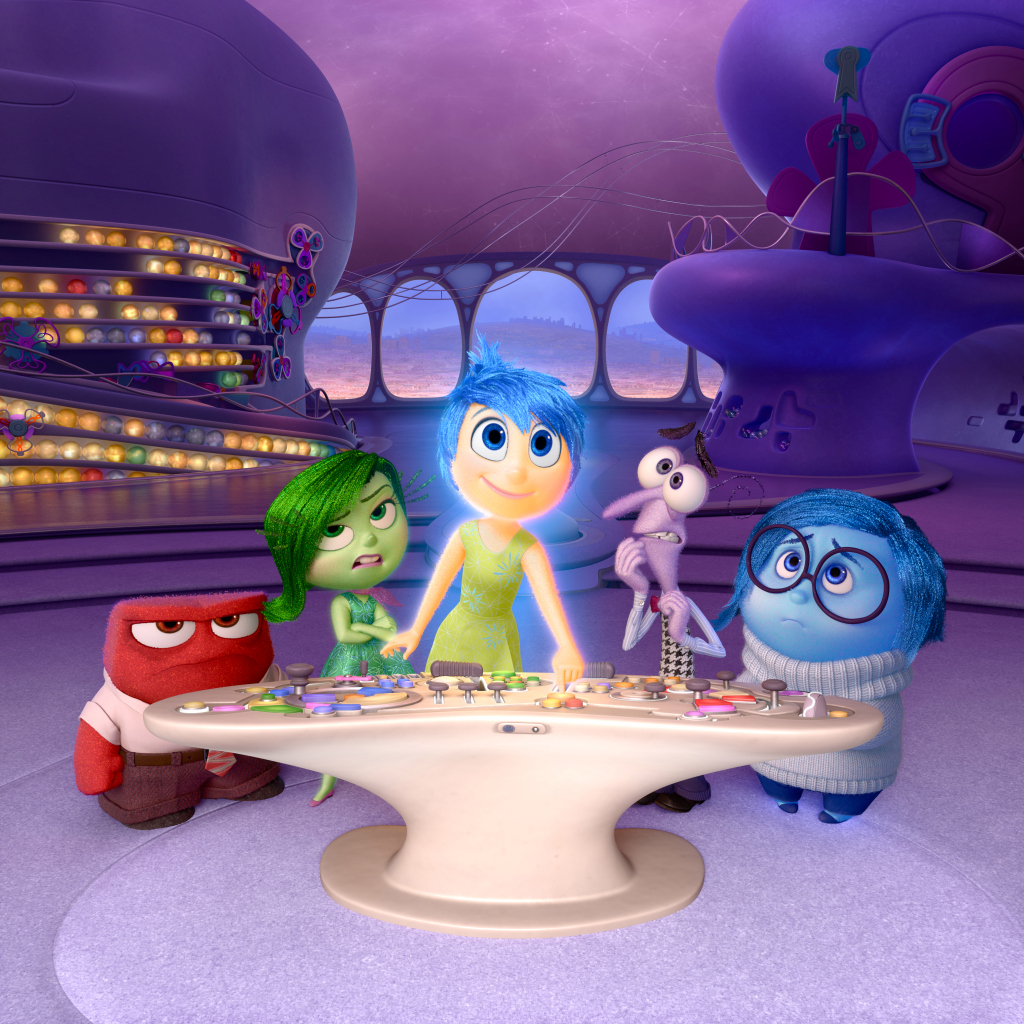How did Pixar solve problems with the filming of "The Puzzle" (The Inside Out)

It's easy to forget that Pixar is a technology company. Mostly because all the inventions that they make serve to improve the presentation of the stories.
In case of success, when everything is done correctly, your attention is captured by presenting the story, and not the technical advances that make it possible. In the movie " Puzzle ", Pixar had its own unique set of technical problems that needed to be overcome. Big ideas lead to great difficulties, and the duality of the film’s history meant the creation of not one, but two whole worlds, not to mention the fact that one of the main characters had to shine.
')
“Puzzle” is the story of a little girl named Riley, who moves to San Francisco from the Midwest with her parents. To some extent, this is a story about how she adapts, and how her family relationships change as the place of residence changes.
But besides this, there is also an internal story telling about her emotions: Joy, Sadness, Fear, Anger, and Disgust. Emotions that affect Riley's feelings, her actions and reactions to events in life - and this is all reflected through a very clever design, which I will not expose in order not to spoil. The double story led to various interesting problems that arise when trying to present and share them so that it helps to tell the story.
I spent a lot of time at Pixar Studios, looked for almost an hour of the footage, and talked with different creative people. I heard dozens of different stories, but two of them turned out to be typical examples of how Pixar can solve technical and creative problems when creating its tools.
More human camera
One of the main obstacles that needed to be overcome was the question of how to make a film that would convey the turbulent, expressive world of internal emotions and at the same time convey the nuances and nuances of the external world of people.
Usually to control the camera in the virtual world of the cartoon uses automatic camera movement. If you need to create an effect of manual shooting of any type, this effect is programmed to simulate a real camera.
When filming "The Puzzle" there were several unusual problems, due to the fact that the worlds inside and outside of consciousness should have been significantly different. Of course, they looked different from an artistic and design point of view. But they also had to be different from the point of view of the viewer. Therefore, different techniques of virtual camera control were used for shooting.
In addition, as the history progressed, the camera movement shifted from the smooth spans, characteristic of the mechanical camera of the thirties, to more modern styles, in which the cameras are controlled manually.

“We behave like the camera crew of a real camera,” says main operator Patrick Lin. - Our main tool is the camera, just our virtual camera. But although it is virtual, mathematically it is accurate. It has lenses, focus, focal length, distortion, depth of field and all that. We imitate the movement of a real camera, as if it were on rails, on a crane, or in the hands of an operator. ”
For filming the world inside Riley's consciousness, an imitation of a more mechanical mode of filming was used. This resulted in smoother camera movement. Riley's world of reality deserved a more manual approach to filming. To emphasize the greater realism of what is happening, more free techniques were used.

For this, the team made an imitation of physical cameras, and attached sensors to them. They broadcast the movement of these cameras to the virtual world, when the operators walked, holding cameras in their hands, and transmitted all the smallest details of camera movement to the virtual scene.
Things like an image that is a bit out of focus give the scene energy as the character moves. Or moments like a camera shake when the operator takes a step from the curb.

Some devices looked like black boxes with wheels from mechanical cameras, similar to real cameras suspended from a crane. Others looked like devices worn on the shoulders with sticks as pointers. One device even consisted of a plastic tripod, with a balancer dangling from it. Lin has already used similar technologies during the shooting of the short film “Blue Umbrella”, which was shown in front of Pixar's “Monsters University”. For the filming of the movie "Puzzle" they used an improved version of this design.
“On the Blue Umbrella site, this technique was still quite young. The device we had was designed by one of our scenery artists, Adam Habib. He also built a focal ring, which could really change the focus so that we could work with the focus in a more natural and familiar way. Everything that we did when shooting was done on purpose, there was nothing accidental. ”
For the “Puzzle”, the entire team of operators used complex camera work. Scenes were made in virtuality, then a real conditional copy of the scene was created on the real set and then the shooting began. Camera movement around the scene resembled the filming of a regular movie - the operators, moving around the real scene, followed the virtual actors as they moved along the virtual scene.
Wearable and mobile devices used to very accurately convey the movement of the camera, depending on what happens on the screen, and whether the transmitted story happens - in Riley's mind or outside. This solution turned out to be both technologically advanced and well adapted for manual work.
RenderMan helps everyone
One of the main characters in the film is Joy, voiced by Amy Poehler, who often appears in trailers and commercials. Joy shines - but it not only shines, it also represents a source of light. A light bulb walking around the scene led to several difficulties that light experts encountered. Angelica Reisch, a leading lighting specialist, says that glowing Joy was one of the most difficult problems.

“We needed to make sure that the light emanating from it was authentic. Therefore, when she moved, it was necessary to achieve the feeling that the light was moving around the stage, she says. - In addition, we wanted to achieve greater detail. If she, for example, lifts a frog - we needed to see the light between her fingers. It was not enough for us to just bring a spotlight on them and highlight everything together. ”
Joy - the main character, not passing, so she had to be present in many scenes in the film. In addition to the other light sources (and in some scenes their number reached 175), we had a moving light source that moved around the stage and confused us with all the maps.
Pixar's director, Ed Katmal, began working on the project, which then turned into RenderMan, and conduct his research at the University of Utah in the seventies. RenderMan became the tool that ILM and LucasArts used to create photorealistic images that were then used in the films: it was used in Titanic, Star Wars, The Lord of the Rings and many others. In 1989, it was opened to all. Now, after 25 years, RenderMan is the legendary product of Pixar, and, in particular, because of him, the company was acquired in 1986 by Steve Jobs. Recently, RenderMan has even become free for those directors who use it for non-commercial purposes.
When it was necessary for the light specialists to depict the light emanating from Joy and exactly corresponding to the structure of her body, and not just some bright spot of light around her, they reached a dead end. But then they discovered what RenderMan programmers were working on at that very time.
“And they were working on what is called the lighting of a geometric region, or geometric light,” says Reish. - This light allows you to choose a model, and make this model a source of light. It was like music to our ears. ”
Geometric light in RenderMan did not plan to finish before the start of the filming of “Puzzles”, but after it became clear that it was needed, the company's engineers got together with the lighting specialists, and managed to bring it to mind in time.
“Around December 2013, I said that at Christmas I only wanted to get a working version of the geometry of light for Joy,” says Reish. “We launched the project with minimal testing in March 2014, but, thank God, it turned out that it works, and we use it in almost every ... or even in every scene of the film.”

The public, of course, will not notice. But this is precisely what says that everything was done correctly. When all problems are solved and all tools are created, they only work to tell a story. The filmmakers get rid of the temptation to boast of technical advances, and in the end, the lighting effects of Joy, or the picture of what is happening in Riley's mind, turn out to be very subtle and elusive. Most people will not know how much work has been done to create such effects, or they will not even notice that Joy is glowing. But we will all feel it - and this is the main thing.
Source: https://habr.com/ru/post/263325/
All Articles